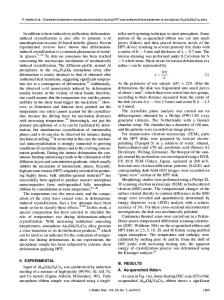Effects of Pressure and Number of Turns on Microstructural Homogeneity Developed in High-Pressure Double Torsion
- PDF / 20,116,121 Bytes
- 15 Pages / 593.972 x 792 pts Page_size
- 60 Downloads / 274 Views
TION
THE demand for nanostructured materials is growing due to tremendous material property improvements that these materials enable, particularly, the strength.[1–4] Both bottom-up and top-down processing methods have been employed to produce refined grain structures. The former includes electrodeposition or magnetron sputtering techniques, which usually leave a highly oriented texture, which can make the material anisotropic with respect to both functional and mechanical properties.[5–10] The latter methods describe severe plastic deformation techniques, such as high-pressure torsion (HPT),[11] equal channel angular extrusion (ECAE),[12–14] co-axial extrusion,[15] and accumulative MOHAMMAD JAHEDI and MARKO KNEZEVIC are with the Department of Mechanical Engineering, University of New Hampshire, 33 Academic Way, Kingsbury Hall, W119, Durham, NH 03824. Contact e-mail: [email protected] IRENE J BEYERLEIN is with the Department of Mechanical Engineering, Materials Department, University of California at Santa Barbara, Santa Barbara, CA 93106. MOHAMMAD HOSSEIN PAYDAR is with the Department of Materials Science and Engineering, School of Engineering, Shiraz University, Shiraz, Iran. SHIJIAN ZHENG and TING XIONG are with the Shenyang National Laboratory for Materials Science, Institute of Metal Research, Chinese Academy of Sciences, Shenyang 110016, China. Manuscript submitted July 2, 2016. Article published online January 5, 2017 METALLURGICAL AND MATERIALS TRANSACTIONS A
roll bonding (ARB).[1,16–21] Of these severe plastic deformation (SPD) techniques, the process that tends to achieve the finest grain sizes for the same material is HPT. Although the samples develop a texture after these processes, it is much more distributed than those produced after deposition methods.[22–27] To enhance material properties, there are many attempts to combine different SPD processes such as applying torsion straining at the exit channel of the ECAE process,[28,29] incorporating torsion with wellknown forward extrusion process,[30,31] combining ECAE and HPT,[32] rolling and HPT[33] as well as ECAE and rolling.[34] All these methods are providing the different strain paths in a material, which lead to more grain refinement and less texture gradient. In HPT, pressure is applied to a disk-shaped sample while it is being torqued. The torque is applied to either the top or bottom of the sample. Theoretically, there is no limit to the number of turns or pressure that can be imposed, and in practice, the material being processed and the die material define these limits.[35,36] A new process called high-pressure double torsion (HPDT) was devised in order to apply more shear strain to the sample per turn.[23,24,37] HPDT is like HPT, except the torque is applied to both the top and bottom of the sample. Thus, the sample is processed approximately twice as fast, i.e., under twice as much strain rate compared to HPT.
VOLUME 48A, MARCH 2017—1249
In prior experimental work, HPT and HPDT were compared for grain refinement efficiency. It was demonstrat
Data Loading...










